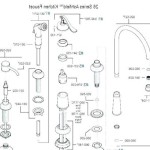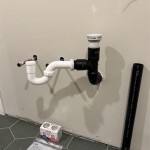Is Drinking Water From The Bathroom Sink Bad?
The question of whether drinking water from the bathroom sink is safe is a common one, often met with varying degrees of concern. While the water supplying the bathroom sink is generally the same as that which supplies the kitchen faucet, several factors can influence the potability of water specifically from the bathroom sink.
Potential Risks of Drinking Bathroom Sink Water
Several potential risks are associated with consuming water directly from a bathroom faucet. These risks warrant careful consideration and understanding.
*
Contamination from bathroom products:
Bathrooms are repositories for a variety of personal care products, including soaps, shampoos, and cleaning agents. Residue from these products can potentially contaminate the sink surface and, consequently, the water dispensed from the faucet. *Bacterial growth in aerators:
Faucet aerators, designed to improve water flow and reduce splashing, can harbor bacterial growth, especially if not regularly cleaned. This bacteria can then contaminate the water stream. *Lead contamination from older plumbing:
In older homes with lead pipes, lead can leach into the water standing in the pipes, particularly after periods of stagnation. This is a higher risk for first-draw water in the morning or after extended periods of non-use. *Lower water pressure fluctuations:
Bathroom sinks sometimes experience lower or fluctuating water pressure compared to kitchen sinks. This can potentially impact the effectiveness of backflow preventers, increasing the risk of contaminated water entering the potable water supply.Factors Affecting Water Quality at the Bathroom Sink
The quality of water dispensed from the bathroom sink isn't universally bad but depends on a combination of factors.
*
Age of plumbing:
Older plumbing systems, especially those containing lead or galvanized steel pipes, pose a higher risk of lead contamination. *Regular cleaning and maintenance:
Routine cleaning of the sink and faucet, including the aerator, significantly reduces the risk of bacterial contamination. *Water source and treatment:
The quality of the municipal water supply and the treatment processes it undergoes play a crucial role in overall water safety. *Presence of a backflow preventer:
Backflow preventers are essential safety devices that prevent contaminated water from being drawn back into the potable water supply. Their presence and proper functioning are crucial.Recommendations for Safe Water Consumption
While the bathroom sink might not be the ideal source for drinking water, certain practices can minimize potential risks.
*
Flush the tap:
Before drinking, flush the tap for a minute or two, especially after periods of non-use, to clear stagnant water from the pipes. *Regularly clean the aerator:
Remove and clean the faucet aerator regularly, preferably monthly, to prevent bacterial growth. *Consider a water filter:
Installing a point-of-use water filter on the bathroom faucet can help remove contaminants and improve water quality. *Test your water:
Periodically testing your home's water for contaminants, including lead and bacteria, can provide valuable insights into water quality and potential risks.Alternatives to Bathroom Sink Water
Several safer alternatives to drinking water from the bathroom sink exist.
*
Kitchen sink:
The kitchen sink is generally the preferred source for drinking water due to its typically higher usage and potentially lower risk of contamination. *Dedicated drinking water tap:
Installing a dedicated drinking water tap, often connected to a filtration system, provides a reliable source of clean drinking water. *Bottled water:
Bottled water, while less environmentally friendly, serves as an alternative, albeit a less sustainable one, for accessing safe drinking water. *Water filter pitcher:
Filtered water pitchers offer a convenient and cost-effective way to filter tap water for drinking.Understanding Your Building's Plumbing
Gaining a basic understanding of your building's plumbing system can be beneficial in assessing the potential risks associated with drinking water from various sources.
*
Material of pipes:
Identify the material of your building's pipes. Lead and galvanized steel pipes pose a greater risk of lead contamination compared to copper or PEX pipes. *Water pressure:
Observe the water pressure at different faucets. Low or fluctuating pressure can indicate potential issues with the plumbing system. *Presence of a water softener:
Water softeners, while beneficial for other purposes, can introduce sodium into the water, which might be a concern for individuals on sodium-restricted diets.Importance of Regular Plumbing Maintenance
Regular plumbing maintenance is crucial for ensuring the overall safety and quality of your home's water supply.
*
Leak detection and repair:
Promptly addressing leaks can prevent water damage and minimize the risk of contamination. *Professional inspections:
Periodic professional plumbing inspections can identify potential issues and ensure the proper functioning of safety devices like backflow preventers. *Water heater maintenance:
Regular water heater maintenance, including flushing the tank, can prevent sediment buildup and improve water quality.
Is It Safe To Drink Bathroom Sink Water

Is It Safe To Drink Water From Your Bathroom Tap
Drinking Water From Your Bathroom Could Be Bad For Health
How To Tell If Water Is Safe Drink Or Contaminated
How To Tell If Water Is Safe Drink Or Contaminated

Is Bathroom Water Safe To Drink Victoriaplum Com

Cloudy Smelly Or Discoloured Water Quality Help Thames

Is Bathroom Water Safe To Drink Victoriaplum Com

9 Signs Of Water Contamination Bob Vila

Why Is Tap Water Bad For You Mspure By Membrane Solutions
Related Posts







